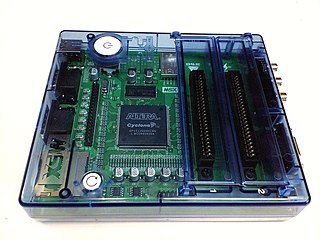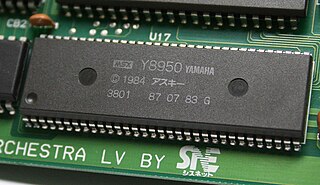
A sound card is an internal expansion card that provides input and output of audio signals to and from a computer under the control of computer programs. The term sound card is also applied to external audio interfaces used for professional audio applications.

MSX is a standardized home computer architecture, announced by ASCII Corporation on June 16, 1983. It was initially conceived by Microsoft as a product for the Eastern sector, and jointly marketed by Kazuhiko Nishi, the director at ASCII Corporation. Microsoft and Nishi conceived the project as an attempt to create unified standards among various home computing system manufacturers of the period, in the same fashion as the VHS standard for home video tape machines. The first MSX computer sold to the public was a Mitsubishi ML-8000, released on October 21, 1983, thus marking its official release date.

Sound Blaster is a family of sound cards and audio peripherals designed by Creative Technology/Creative Labs of Singapore. The first Sound Blaster card was introduced in 1989.
The Environmental Audio Extensions are a number of digital signal processing presets for audio, present in Creative Technology Sound Blaster sound cards starting with the Sound Blaster Live and the Creative NOMAD/Creative ZEN product lines. Due to the release of Windows Vista in 2007, which deprecated the DirectSound3D API that EAX was based on, Creative discouraged EAX implementation in favour of its OpenAL-based EFX equivalent – though at that point relatively few games used the API.

The X68000 is a home computer created by Sharp Corporation. It was first released in 1987 and sold only in Japan.

The Gravis UltraSound or GUS is a sound card for the IBM PC compatible system platform, made by Canada-based Advanced Gravis Computer Technology Ltd. It was very popular in the demoscene during the 1990s.

The Roland MT-32 Multi-Timbre Sound Module is a MIDI synthesizer module first released in 1987 by Roland Corporation. It was originally marketed to amateur musicians as a budget external synthesizer with an original list price of $695. However, it became more famous along with its compatible modules as an early de facto standard in computer music. Since it was made prior to the release of the General MIDI standard, it uses its own proprietary format for MIDI file playback.

The YM2413, a.k.a. OPLL, is an FM synthesis sound chip manufactured by Yamaha Corporation. It is related to Yamaha's OPL family of FM synthesis chips, and is a cost-reduced version of the YM3812 (OPL2).
The Korg Trinity is a synthesizer and music workstation released by Korg in 1995. It was Korg's first modern workstation and marked a significant evolution from its predecessors by offering features such as built-in digital audio recording, 32-note polyphony, an extensive internal sound library, assignable effects, and a large touchscreen for advanced control and editing functions, a feature not previously seen on any musical instrument. It also offered modular expansion for not only sounds, but also studio-grade features such as ADAT, various sound engine processors, audio recording capability, and more.

Soundscape S-2000 was Ensoniq's first direct foray into the PC sound card market. The card arrived on the market in 1994. It is a full-length ISA digital audio and sample-based synthesis device, equipped with a 2 MiB Ensoniq-built ROM-based patch set. Some OEM versions of the card feature a smaller 1 MiB patch set. It was praised for its then-high quality music synthesis and sound output, high compatibility and good software support.

The Ensoniq AudioPCI is a Peripheral Component Interconnect (PCI)-based sound card released in 1997. It was Ensoniq's last sound card product before they were acquired by Creative Technology. The card represented a shift in Ensoniq's market positioning. Whereas the Soundscape line had been made up primarily of low-volume high-end products full of features, the AudioPCI was designed to be a very simple, low-cost product to appeal to system OEMs and thus hopefully sell in mass quantities.

The Sound Blaster 16 is a series of sound cards by Creative Technology, first released in June 1992 for PCs with an ISA or PCI slot. It was the successor to the Sound Blaster Pro series of sound cards and introduced CD-quality digital audio to the Sound Blaster line. For optional wavetable synthesis, the Sound Blaster 16 also added an expansion-header for add-on MIDI-daughterboards, called a Wave Blaster connector, and a game port for optional connection with external MIDI sound modules.

The Sound Blaster AWE32 is an ISA sound card from Creative Technology. It is an expansion board for PCs and is part of the Sound Blaster family of products. The Sound Blaster AWE32, introduced in March 1994, was a near full-length ISA sound card, measuring 14 inches (356 mm) in length, due to the number of features included.

Media Vision Technology, Inc., was an American electronics manufacturer of primarily computer sound cards and CD-ROM kits, operating from 1990 to approximately 1995 in Fremont, California. Media Vision was widely known for its Pro AudioSpectrum PC sound cards—which it often bundled with CD-ROM drives—it is also known for its spectacular growth and demise.

The One chip MSX, or 1chipMSX as the D4 Enterprise distributional name for the ESE MSX System 3, is a re-implementation of an MSX-2 home computer that uses a single FPGA to implement all the electronics of an MSX-2, including the MSX-MUSIC and SCC+ audio extensions.

The Yamaha Y8950 is a sound chip, produced in 1984. It is also known as MSX-Audio as it was designed for inclusion in an expansion cartridge for the MSX personal computer.

The Philips NMS-1205 was a MSX AUDIO cartridge using the Yamaha Y8950 chip . NMS-1205 was only sold in Europe for the MSX Personal Computer.
The Yamaha YMF278 or YMF278B, also known as the OPL4, is a sound chip that incorporates both FM synthesis and sample-based synthesis by Yamaha.
The OPL series are a family of sound chips developed by Yamaha. The OPL series are low-cost sound chips providing FM synthesis for use in computing, music and video game applications.














